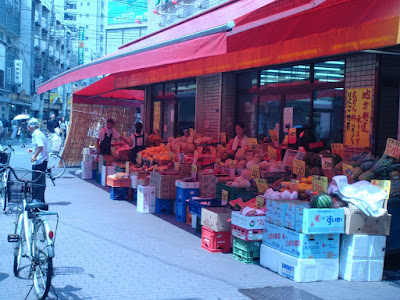
Kijōyu udon is an orthodox and old-skool way to eat sanuki udon. It consists simply of freshly boiled noodles (dunked in ice water to as soon as they're just the right state of al dente to keep the koshi*), and garnished with a raw egg yolk, a splash of a soy sauce mixture and a few spice condiments called yakumi, like chopped scallions or sesame seeds, and finito. Break the yolk, toss it with the noodles and it's almost like a Japanese carbonara.
* Koshi refers to the elasticity of Japanese noodles, describing the state when it satisfies all of the following: firmness, suppleness and bouciness, especially as they go down your throat, as you don't "chew" Japanese noodles so much as swallow them. Scout's honor. Actually, udon is much more about the texture than the flavor.

Hinaya also serves it with natto, or fermented beans, for those of you who can stomach it. For me, this is the perfect breakfast. Egg! Noodles! Natto! What's not to like?

But of course my favorite all-time Hinaya udon (and the shop's #1 menu item) is the curry udon. The only vegetables that go into the roux are onions and carrots--which are sauteed until they are soft and sweet, and then pureed. The puree, curry spices and water are boiled for hours until the roux is rich and thick, at which time she meets her soulmate, the smooth and elegant otsuyu, or dipping sauce, and poured over oodles of noodles. It's a match made in heaven, and if not heaven, at least the greater Tokyo area. Served with a soft-boiled onsen tamago egg, yakumi and toasted abura age (fried tofu, prounounced "a-gé"), it's addictive.


Other popular udon are goma dare udon, or cold udon with a savory and creamy sesame dipping sauce, and kama tama udon, served piping hot in the water they were boiled in. It's hard-core and authentic. Or something. Lunch sets at Hinaya are ¥900 (including your choice of udon, the daily rice, and two side dishes).

Oh, and by the way, my dad makes everything fresh, including the udon noodles. From the flour to the salt to the water to the width they are cut, they all have to pass dad's test, every day. The noodles themselves are vegan--flour, salt and water are the only three ingredients that go in.

麺 men
生醤油 kijōyu
コシ koshi
薬味 yakumi
納豆 natto
おつゆ otsuyu
温泉たまご onsen tamago
油揚げ abura age
ゴマだれ goma dare
Hinaya (日南家)
2-14-7 Akasaka, Minato-ku
T/F 03-3583-0178
http://akasakahinaya.blogspot.com



